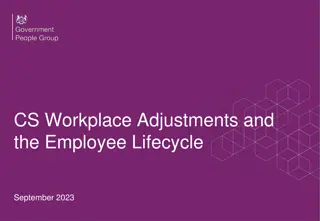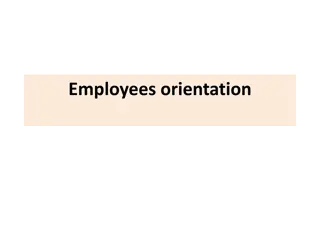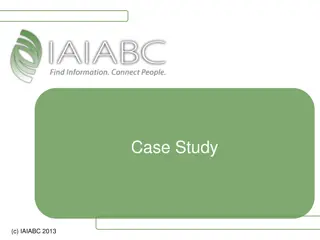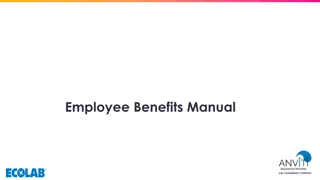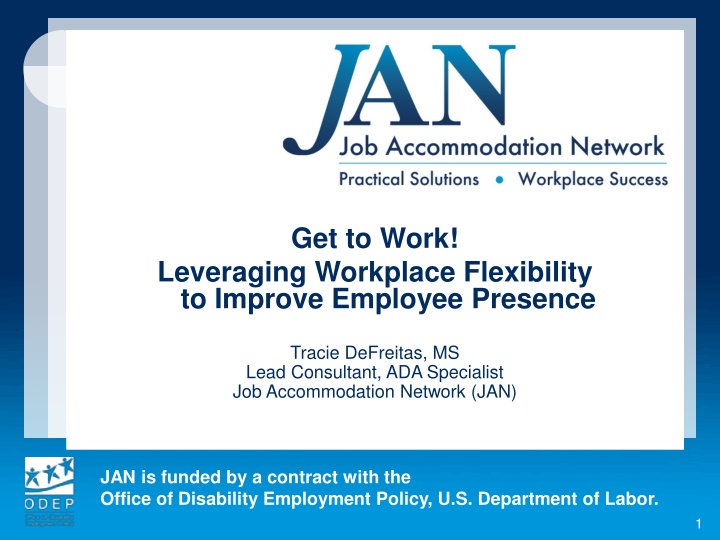
Leveraging Workplace Flexibility for Improved Employee Presence
Learn how workplace flexibility can enhance employee presence and productivity, focusing on ADA accommodation basics, presence barriers, and the significance of the Americans with Disabilities Act (ADA) in promoting equal opportunities in employment.
Download Presentation

Please find below an Image/Link to download the presentation.
The content on the website is provided AS IS for your information and personal use only. It may not be sold, licensed, or shared on other websites without obtaining consent from the author. If you encounter any issues during the download, it is possible that the publisher has removed the file from their server.
You are allowed to download the files provided on this website for personal or commercial use, subject to the condition that they are used lawfully. All files are the property of their respective owners.
The content on the website is provided AS IS for your information and personal use only. It may not be sold, licensed, or shared on other websites without obtaining consent from the author.
E N D
Presentation Transcript
Get to Work! Leveraging Workplace Flexibility to Improve Employee Presence Tracie DeFreitas, MS Lead Consultant, ADA Specialist Job Accommodation Network (JAN) JAN is funded by a contract with the Office of Disability Employment Policy, U.S. Department of Labor. 1
Get to Work! Presence Barriers Americans with Disabilities Act (ADA) Basics Who qualifies to receive accommodation Recognizing a request for accommodation Accommodation Issues Modifying a policy about where work is performed Modifying a schedule Modifying an attendance policy Providing leave 2
Attendance/Presence Barriers Personal medical needs (appointments, medication/treatment, wound care) Commuting barriers (stamina, restroom access, pain, seizure activity, vision loss) Effect of treatment (suppressed immune system, drowsiness, light sensitivity) Personal hygiene needs (incontinence) Accessibility barriers (lack of accessible parking, location) Environmental exposures (construction, fragrance, foods) 3
Celebrating 30 Years of the ADA! The ADA is a civil rights law, signed into law on July 26, 1990, by President George H.W. Bush, that prohibits discrimination against individuals with disabilities Divided into five titles that relate to different areas of public life JAN s focus is on title I, employment 4
ADA, Title I - Employment Americans with Disabilities Act (ADA), Title I Federal civil rights statute; removes barriers to equal employment for individuals with disabilities who are qualified ADA Amendments Act (ADAAA) of 2008 Prohibits covered entities from discriminating against qualified individuals on the basis of disability, in all employment practices and during all stages Requires reasonable accommodation for the known disability of a qualified applicant or employee barring undue hardship 5
ADA Basics What is meant by reasonable accommodation ? A change or adjustment to a job or work environment that permits an applicant or employee with a disability to participate in the hiring process, to perform the essential functions of a job, or to enjoy equal benefits and privileges Reasonable means feasible or plausible possible to provide without undue hardship Undue hardship an action requiring significant difficulty or expense RA must be effectivefor the purpose (e.g., enables employee to perform essential functions) 6
ADA Basics Who is entitled to receive accommodation under title I of the ADA? Applicants and employees Individual with a disability who is qualified Has an actual or record of a disability (ADA) Meets qualification standards for the position Can perform all essential functions w/wo accommodation Can meet production/performance/conduct requirements 7
ADA Basics What about caregivers of IWDs? Not entitled to receive reasonable accommodation under the ADA Only an employee with an actual or record of a disability AskJAN.org A to Z by Topic: Caregivers Parents as Caregivers, Not Qualified Employees Other resources: Employer Best Practices for Workers with Caregiving Responsibilities Enforcement Guidance: Unlawful Disparate Treatment of Workers with Caregiving Responsibilities 8
ADA Basics What is a request for accommodation? An applicant or employee asks for an adjustment or change at work for a reason related to a medical impairment I'm having difficulty concentrating because of medication side effects. An employee returns to work using a wheelchair and says the wheelchair won t fit under their desk A note from a healthcare provider indicates the need for 3 months of leave for medical treatment I need to go to counseling appointments once a week and would like to flex my schedule those days. Impairment causing a problem + work-related barrier = request for accommodation 9
Same Benefit - Extra Hoops? What is not a request for accommodation? Request for the same workplace adjustments/access to benefits available to similarly situated employees (e.g., flex schedule, telework, ergonomic equipment) unless requesting something beyond the benefit Also: Voluntary self-identification of disability (e.g., Section 503, Affirmative Action) Disability disclosure absent work-related barrier or specific request 10
ADA Basics How can it be determined that an individual qualifies to receive reasonable accommodation? Follow ADA disability-related inquiry rules Gather information to process the RA request; details about the impairment, limitations, impact on performing job duties, and accommodation ideas Determine if the individual has a disability under the ADA Practical guidance on gathering information during the current COVID-19 pandemic: The ADA and Managing Reasonable Accommodation Requests from Employees with Disabilities in Response to COVID-19 11
Attendance/Presence Barriers Personal medical needs (appointments, medication/treatment, wound care) Commuting barriers (stamina, restroom access, pain, seizure activity, vision loss) Effect of treatment (suppressed immune system, drowsiness, light sensitivity) Personal hygiene needs (incontinence) Accessibility barriers (lack of accessible parking, location) Environmental exposures (construction, fragrance, foods) 12
Solutions for addressing Personal Medical Needs Leave for medical appointments Flexible schedule for medical appointments Reduced work schedule Breaks to take medication, eat, lie down Privacy/private workstation Work at home for self-care, to receive treatment Service or emotional support animal Personal Assistance Services (PAS) Commuting Barriers Flexible schedule to access public transportation Accessible parking, facility Work at home to skip the commute 13
Solutions for addressing Effects of Treatment Work at home to avoid exposure to germs Work at home with flexible schedule to work at most productive time Work at home to skip the commute Modified schedule and modified attendance policy to allow window of arrival Frequent breaks/modified break schedule to use the restroom Leave Personal Hygiene Needs Frequent breaks/modified break schedule to use the restroom Work at home to skip the commute PAS 14
Solutions for addressing Accessibility Barriers Accessible entrance, restrooms, workstation Accessible/designated parking Temporary alternative workstation Work at home or alternative location Flexible schedule to access public transportation Environmental Exposure Issues Temporary alternative workstation Work at home or alternative location Implement a policy (e.g., fragrance, food) Remote access (e.g., meetings, training) 15
Work at Home/Telework Is it a form of accommodation to allow an employee with a disability to work at home? Yes. May be expected to modify policy concerning where work is performed if such a change is needed as an accommodation if reasonable and barring undue hardship (EEOC) May have to consider even if other employees are not allowed to work at home May provide alternative accommodations that enable an employee to work in the workplace, if effective AskJAN.org, A to Z by Topic: Telework Work at Home/Telework as a Reasonable Accommodation Work at Home/Telework as a Reasonable Accommodation Work at Home/Telework as a Reasonable Accommodation Work at Home/Telework as a Reasonable Accommodation EEOC 16
Telework and COVID-19 Response to state or local stay-at-home order and/or business effort to control exposure Accommodation to avoid risk of exposure for individuals with disabilities who are at high risk for developing serious complications from COVID-19 Pandemic Preparedness in the Workplace and the ADA (EEOC), Section III. ADA-compliant Employer Practices for Pandemic Preparedness, Part B, Q. 10 17
Questions to Consider Can the essential functions of the employee s position, all or any, be performed away from the workplace? Does the work require in-person interaction with colleagues, clients/patients/customers, and can communication occur in an alternative way? Will the employee have access to the general equipment, resources, and information needed to perform required tasks at home? When will the employee be expected to complete tasks and be available to work? How will the employee be supervised and performance be measured? 18
Telework and Accommodations Pre COVID-19: Accommodations at home: Complex and not addressed by ADA regulations or formal RA/UH EEOC enforcement guidance (e.g., equipment needed in the home) During COVID-19 Pandemic: Pandemic Preparedness in the Workplace and the ADA (EEOC), Section III. ADA-compliant Employer Practices for Pandemic Preparedness, Part B, Q. 14 During a pandemic, if IWD needs the same reasonable accommodation at a telework site that was provided at the workplace, employer should provide that accommodation absent undue hardship 19
Telework Practical Guidance Define essential job functions to be performed at home during this pandemic situation Document parameters of the temporary telework arrangement and draft an agreement (e.g., why and when permitted, for what duration, supervision, etc.) Make tools, information, and equipment available Provide accommodations that are reasonable Provide the support needed to work effectively (e.g., IT) Develop work goals and performance expectations and apply requirements 20
Modifying a Schedule Must an employee with a disability be allowed to work a modified/flexible/part-time schedule as an accommodation? Yes if reasonable and not an undue hardship Even if this flexibility is not provided to other employees The time an essential function is performed may be critical and could affect ability to approve as RA Not reasonable? Consider reassignment to a vacant position to work during the hours requested Reasonable Accommodation and Undue Hardship Under the ADA Reasonable Accommodation and Undue Hardship Under the ADA EEOC 21
Modifying a Schedule Adjusting arrival or departure times Allowing a window of arrival Allowing a flexible schedule Allowing part-time or reduced work schedule Allowing periodic breaks, additional breaks, or a modified break schedule Altering when certain functions are performed Changing a shift Reducing work hours or allowing use of leave 22
Questions to Consider Are other employees in the same position permitted to work a modified/flexible/part-time schedule? For what frequency and duration is the schedule modification needed? As-needed, only on treatment days, every day, etc. To return to work, temporarily, permanently, indefinitely Will the accommodation impact how/when essential functions are performed? Time a store opens, when customers are served Is a modification to the attendance policy also necessary to implement the accommodation? 23
Questions to Consider If requesting part-time, is the employee eligible for reduced work schedule leave under FMLA? What notice will be required? Notify supervisor by e-mail, call-in by certain time, etc. Will time be made-up or leave applied? What about FMLA? Who needs to be informed about this type of accommodation? Supervisor may need to know that late arrival is approved Parking garage or security may need to know that employee has access 24
Informing Others, and Not May other employees be informed that an individual is receiving accommodation? Supervisors and managers may be informed about restrictions and accommodations but, restrict the sharing of disability-related information May not disclose that an employee is receiving a reasonable accommodation all disability-related information must be kept confidential May inform those who are on a need-to-know basis only this does not include co-workers 25
Informing Others, and Not May find it useful to point out The employer has policy of assisting any employee who encounters difficulties in the workplace, that many workplace issues encountered by employees are personal, and that in these circumstances, it is the employer's policy to respect employee privacy EEOC, Reasonable Accommodation and Undue Hardship Under the ADA Q. 42 JAN Blog, The Manager s Dilemma: An employee is asking about a co-worker s accommodation. As a manager, what do I say? 26
Practical Guidance Document parameters of the modified schedule arrangement Define window of arrival and consequences of not arriving within the window Define break parameters Request disability-related documentation to support the need for breaks, tardiness, absences Inform those who must know about accommodation 27
Part-time Schedule Must a full-time job be changed to part-time as an accommodation under the ADA? Maybe, but not a clear cut issue EEOC guidance states that part-time work is a form of reasonable accommodation, but also states that employers do not have to create new jobs Err on the side of caution and consider a request to change an employee s job to part-time unless it poses undue hardship UH? Consider reassigning the employee to an existing, vacant part-time job Pay and benefits? Check wage and hour laws 28
Providing Leave Is there a duration of leave that is required as an accommodation under the ADA? No ADA is not a leave law. Leave is a form of accommodation Employees with disabilities must be provided with access to leave on the same basis as all other similarly-situated employees (e.g., personal or medical leave policy, FMLA, etc.) Engage in an interactive process to determine if accommodation is warranted under the ADA and if leave is reasonable 29
Providing Leave Allowing use of accrued leave or unpaid leave, as-needed Allowing intermittent and/or extended leave Allowing time to be made-up Modifying attendance policy to allow absences related to medical impairment Providing access to FMLA Providing leave as accommodation, beyond FMLA leave 30
Providing Leave Employer has discretion to determine how much leave is reasonable Requires case-by-case analysis Not expected to completely disregard time and attendance irregular, unreliable attendance UH? Accurately and objectively assess and document the impact of absences on business operations Keep a log Document facts, not feelings! 31
Commuting Assistance Is commuting assistance required as an accommodation? Employers are generally not responsible for transporting employees to and from work But, when an employee s disability interferes with their ability to commute to work, employers may have to provide accommodations to enable presence: Schedule modification Accessible parking Alternative workstation Work at home Reassignment 32
PAS What are Personal Assistance Services (PAS)? Assistance with performing activities of daily living that an individual would typically perform if did not have a disability and that is not otherwise required as a reasonable accommodation PAS enables individuals with disabilities to participate/be in the workplace Assistance with: Using the restroom Eating and/or taking medication Putting on and taking off outerwear 33
Resources AskJAN.org - A to Z: Commuting Issues https://AskJAN.org/workrelatedfunctions/Commute.cfm Leave https://AskJAN.org/topics/leave.cfm Modifying a Schedule https://AskJAN.org/concerns/Modified-Schedule.cfm PAS https://AskJAN.org/topics/persassist.cfm Parking https://AskJAN.org/topics/parking.cfm Reassignment https://AskJAN.org/topics/Reassignment.cfm Sample Forms https://AskJAN.org/topics/Sample-Forms.cfm Telework https://AskJAN.org/topics/telework.cfm 34
Resources EEOC ADA Enforcement Guidance Reasonable Accommodation and Undue Hardship Employer-Provided Leave and the ADA Work At Home/Telework as a Reasonable Accommodation JAN Employers' Practical Guide to Reasonable Accommodation Employees' Practical Guide to Requesting and Negotiating Reasonable Accommodation The Interactive Process Workin 9 to 5 Not the Only Way to Make a Living 35
COVID-19 ADA Related Resources JAN COVID-19 resource page Engaging in the Interactive Process During the Covid-19 Pandemic The ADA and Managing Reasonable Accommodation Requests from Employees with Disabilities in Response to COVID-19 Coronavirus (COVID-19), Stress, and Mental Health Conditions EEOC resources Pandemic Preparedness in the Workplace and the ADA What You Should Know About COVID-19 and the ADA, the Rehabilitation Act, and Other EEO Laws EEOC webinar addressing questions arising under Federal Equal Employment Opportunity laws and the COVID-19 pandemic Webinar transcript 36
Questions? Tracie DeFreitas Lead Consultant, ADA Specialist Job Accommodation Network (JAN) defreitas@jan.wvu.edu Contact JAN Live Chat jan@AskJAN.org AskJAN.org (800) 526-7234 (V) (877) 781-9403 (TTY) 37


